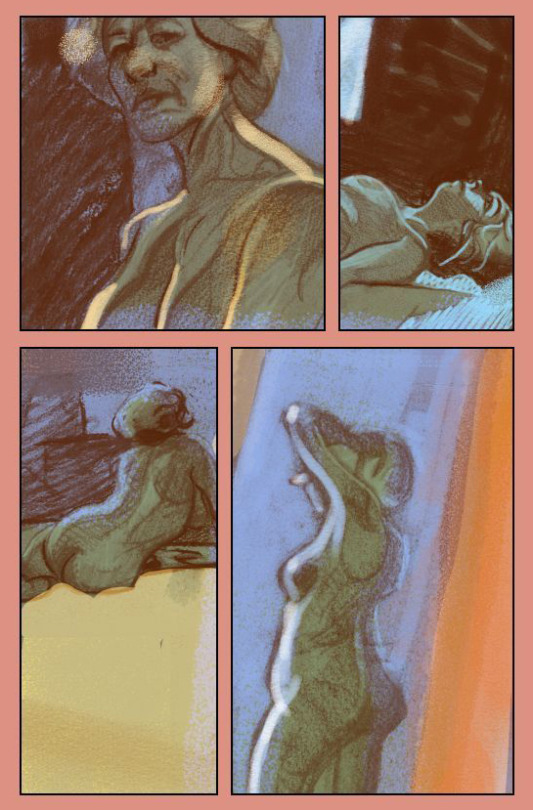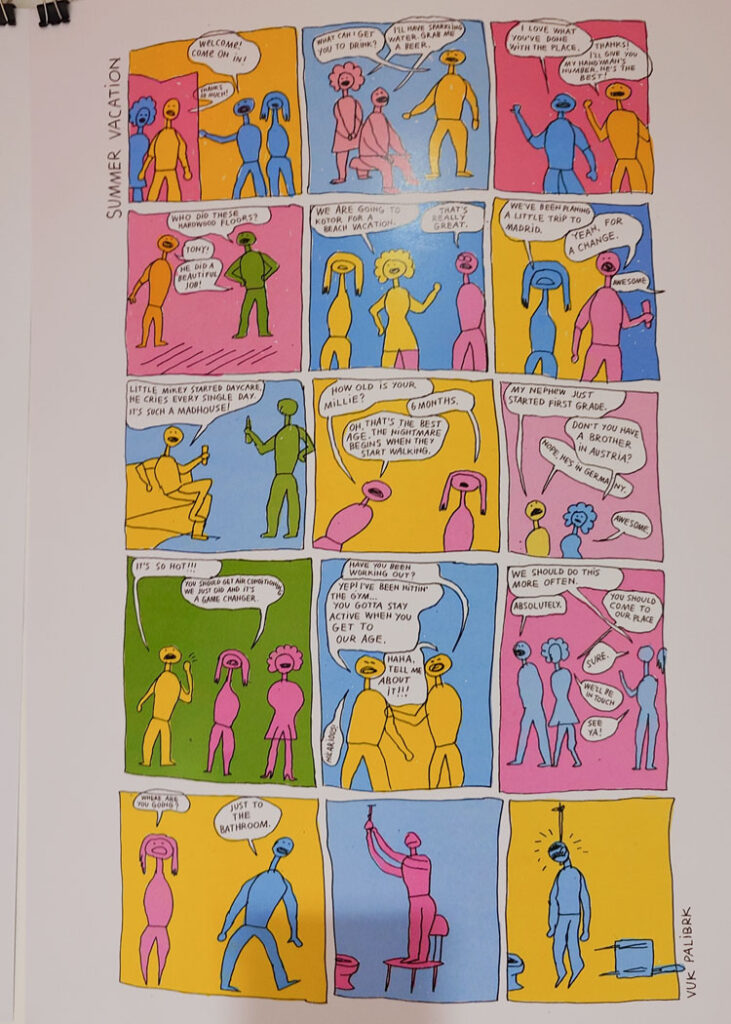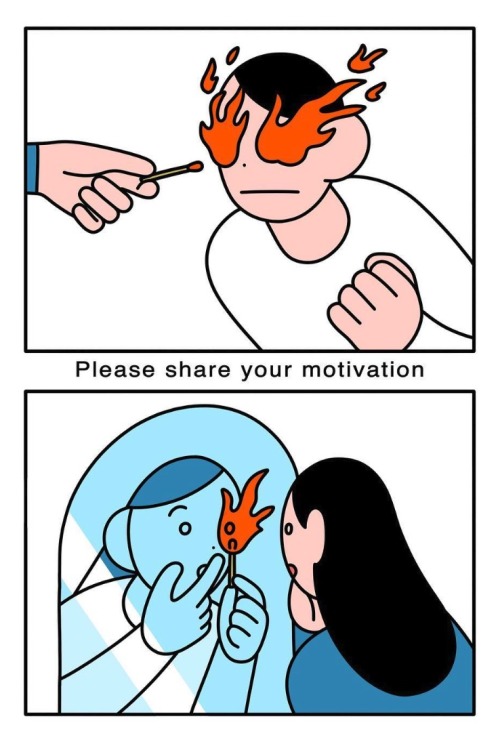I didn’t think that UK politics could be rendered more unpleasantly-risible, but the return of George Galloway to Parliament (and for those readers to whom this name means nothing, please do yourselves the favour of watching this, keeping in mind throughout that this man was just democratically selected by several thousand people as the best person to represent their interests and DEFINITELY NOT just to feather his own nest and reinvigorate his media profile) has unexpectedly upped the ridiculousness ante – WELL DONE, PEOPLE OF ROCHDALE!
Still, on the plus side, FEBRUARY IS OVER WELL DONE YOU SURVIVED! Consider this week’s edition of Web Curios a reward for your continued existence – you deserve it, you’re worth it and don’t let anyone tell you otherwise.
I am still Matt, this is still Web Curios, and if I could reach through the screen I would give you the very gentlest of pinches and punches.

By Clayton Schiff (and via TIH, along with the rest of this week’s pics)
LET’S START THE WEEK’S LINKS AND WORDS WITH A NEW VINYL MIX BY THE RELIABLY-TASTEFUL TOM SPOONER!
THE SECTION WHICH CAN NOW QUITE HAPPILY LIVE OUT THE REST OF ITS DAYS WITHOUT SEEING ANY MORE REFENCES TO THE FCUKING WONKA THING, PT.1:
- Google DJ: Do kids these days still think of ‘DJ’ as a vaguely-cool and aspirational profession, or is it simply ‘something old people thought was fun in the 90s, when people still went out and one could cling on to the hope that things might one day get better’? No matter, because THE MACHINES ARE COMING and the days when one of us fleshsacks could exchange three hours behind the decks for beer tokens appear to be running out – or at least that was very much the feeling I got from this latest, terrifyingly-impressive, AI music toy from Google, which (and I’m really not exaggerating here) allows you to conjure up a seamless, on-the-fly, machine-generated soundscape based on whatever you type in, one which will change and shift in realtime as you edit the prompts. Which, I appreciate, is possibly a bit hard to get your head around, but I promise it’s incredibly intuitive and makes total sense when you play with it – effectively you have a number of text-to-music ‘tracks’ which you use to specify the type of sounds you want to hear, and these prompts are mixed as-you-listen into a basically-seamless soundscape. This is FCUKING INCREDIBLE – ok, yes, nothing I have made it produce so far is going to make David Guetta tremble with fear in his private jet, but this is…you know what, this produces sounds that are AT LEAST as good as about 40% of the fcuking terrible deep house sets I was compelled to sit through in bars throughout the 00s, and the way you can tweak and shift the tone and style and pace of the mix in whatever way you can imagine is pretty astonishing, as is the fact that, so far at least, I haven’t been able to make it create anything unlistenable (and believe me I have tried). Honestly, this is HOURS of knob-twiddling fun, and may at last mean that we can foresee a future in which hardcore pioneers Ratpack and Nicky Blackmarket can finally take a weekend off, having seemingly been gigging nonstop since 1992. We really are getting to the point where this stuff is GOOD ENOUGH and is going to start getting deployed all over the place, whether we like it or not – buckle up.
- Pogichat: After about two years of plaintively typing ‘someone should really make a new tamagotchi-style digital pet with all this new generative AI kit’ like some sort of pathetic, needy child, MY PRAYERS HAVE BEEN ANSWERED! Pogichat is literally exactly what I had imagined – a simple interface in which you’re presented with a…thing (a blob that sort-of looks a bit like a duck if you squint – safe to say I’m not bowled over by paternal feelings of warmth, based on the design), presumably the titular ‘Pogi’, and a series of simple commands which let you interact with it in various ways (feed, play, talk, etc), all of which are mediated by some sort of under-the-hood LLM, meaning there’s a pleasing degree of elasticity in the responses and the interactions – it ‘understands’ what you say to it *(obviously it understands nothing, but you get what I mean), meaning that if you’re a particular sort of digital sadist you can amuse yourself by sending increasingly cruel and pointed messages to your digital charge and watch its mood plummet as you repeatedly remind it of the two-dimensional futility of its digital prison (but know that if you do that I am judging you INCREDIBLY harshly- look at Pogi’s face! Poor pogi!). This is very light and very silly, but it gave me a real ‘you could do SO much more here’ feeling (which is obviously typical of someone who couldn’t make something like this themselves if they tried). See if you can get Pogi to fall in love with you / kill itself (delete per your particular perversions).
- Make Your Own AI Watch: While we wait for the first of the coming wave of AI-enabled wearables to hit the market and disappoint all the early adopters (inevitably), why not take the open source route and hack your Apple/Samsung/Sony smartwatch so that instead of being a glorified step tracker it instead becomes an ALL-KNOWING AI ASSISTANT???? This is the github page for a slightly-astonishing open source project which promises to let you run an AI off your wrist, with options to pull together all sorts of different bits of kit to spin up your own bespoke digital assistant which will be able to leverage all the sensors and subsequent data collected by your phone to…I don’t know, make all sorts of weird an erroneous inferences about your life. It’s slightly unclear as to what exactly ‘an AI in your smartwatch’ might actually deliver in terms of benefits, but WHO CARES IT’S SO FUTURE AND SCIFI!
- Bookpecker: Why do you read books? Is it to glory in the beauty of the written word? To enjoy the meter and cadence of language, the feeling of someone else’s thoughts weaving their way through your own? No, of course not, that would be WEIRD – instead, I imagine you read because KNOWLEDGE IS POWER and YOU WANT POWER and as such you grit your teeth and read the books because THEY ARE THE GATEWAY TO SUCCESS. Or at least that’s the viewpoint I imagine the likely audience for Bookpecker has – people who are so BUSY, so VITALLY ALPHA, that their every waking moment is engaged in maximising their ADVANTAGE, and who devour business books inbetween chugging protein shakes and setting up dropshipping/NFT/AI (delete as applicable) businesses. Bookpecker is…I don’t know, I initially thought it was depressing and sad, but on reflection it’s impossible to be miserable about something so utterly idiotic and obviously aimed at people who think Stephen Bartlett is someone worth listening to. You know those self-help and business books that are always on sale at airports and which obviously sell loads of copies despite you never actually seeing anyone reading one in the wild? The ones that tell you that YOU TOO can be a success as long as you, I don’t know, ‘believe really hard’? Well what if I told you that there was a way to get ALL OF THE WISDOM from said books without actually having to wade through the dead-eyed prose? OH HAPPY DAY! Bookpecker does exactly that – there are seemingly HUNDREDS of business-type books (and history books, and biographies, and science books, and basically all of the non-fiction you can think of) on the site, each of which has been reduced from its original length to…FIVE BULLET POINTS! That’s right! You too can get ALL OF THE INFORMATION and ALL OF THE VALUE of, for example, ‘A Brief History of Time’, summarised in a few short sentences (no, really, you can), presumably by an LLM. This would be incredibly depressing were it not for the amusement I’m deriving from imagining the likely target audience for this SPECTACULARLY moronic website.
- Vids-From-Photos: A brief check-in at the edges of the ‘photo-to-video’ tech pipeline now – this link takes you to a technical paper which, honestly, is all gibberish to me, but which contains half-a-dozen examples of experimental tech which is being used to create lipsynced videos from single photos or illustrations and FCUKING HELL this is incredible and genuinely disconcerting in how convincing it is. The idea here is that you take an audio track, point it at an image of someone’s face and the software will create a lipsynced animation from the photo, complete with some additional (and weirdly-convincing) movements to additional verisimilitude and BOOM, anyone can spin up a genuinely-impressive video of a talking head saying anything they fancy, in seconds. Between that and this week’s ‘hairy chested AI McDonald’s man’ photo I think we’re just about crossing the ‘you really can’t believe a fcuking thing you see online anymore’ rubicon, and I don’t think I like it one bit.
- A Genuinely Terrifyingly Good AI-Generated Song: Click this link. Leave it open in the background while you read the next section. As you half-listen to it, can you tell it’s an AI-generated track? NO YOU FCUKING CAN’T DON’T LIE TO ME! This is insane – it genuinely does sound like a ‘lost’ 1950s rock and roll track, and the fact that it’s old and a bit crackly masks some of the oddities at the edges, and it’s got…it’s got a tune! And there’s a FCUKING GUITAR SOLO halfway through! Just to reiterate what I said at the top of this week’s issue, it really does feel like we’re in the process of crossing a threshold because, honestly, I am revising my estimates for ‘when the first AI-generated track to receive mainstream radio play is going to hit’ down by about a year.
- Zaltor: Do you feel lost and uncertain and confused? Do you lack direction and drive? Do you find yourself looking to the future with trepidation and fear, unsure of what path to take through the seemingly-sinister gathering mists of THE FUTURE? Yeah, well, join the fcuking club, you’re not SPECIAL you know. Still, if you’d like some sort of digital Virgil to guide you through all the WEIRDNESS OF THE NOW, perhaps Zaltor will fit the bill – you’ll need to use your phone for this one, but the url takes you to a neat little LLM-enabled ‘Ask The Oracle’-type game, which lets you ask three questions of THE MYSTERIOUS ZALTOR and receive suitably-gnomic responses in reply. Amazingly Zaltor accurately predicted the result of last weekend’s Carabao Cup Final (yeah thanks for that you scrying digital pr1ck) – that said, he also just told me that ‘the team with red and white stripes’ is going to win the FA Cup, so possibly don’t go basing any betting or investment decisions on The Machine’s prognostications. Still, might be fun to spend the weekend relying solely on Zaltor’s suggestions (NB – Web Curios, as ever, accepts not responsibility for anything that should result from you following this evidently idiotic idea).
- Tasmania: Or, specifically, a nice little promo from the Tasmanian tourist board which also neatly illustrates the fact that, occasionally, there really are great links in Web Curios which really can be used as ‘inspiration’ (ahem) for your own projects. In the first Curios of the year I featured this site, where an artist called Pablo was riffing on the idea of AI art and offering to do drawings based on ‘prompts’ submitted to his site by people around the world – and now that EXACT idea has been lifted, wholesale, in this project – except in this case, the prompts will be executed by artists native to Tasmania, neatly promoting both the region and the creatives working there. In a nice twist, those whose prompts get selected to be envisioned by the artists will (eventually) get the physical work mailed to them, which is a lovely touch, and overall this is a really cute bit of PR for both the place and the people making the work. It seems that you’ll have more of a chance of your prompt being picked if it references Tasmania in some way, but I live in hope that I’ll get lucky and my dream commission ‘ – ‘Mel Gibson being fisted by a wallaby’, since you ask – will be winging its way to me soon.
- Flip Shop: Are we all going to become influencers? Given the fact that ALL THE JOBS ARE GOING TO VANISH, will we all be reduced from attempting to earn affiliate pennies by flogging leisurewear to our friends and family? Is the global economy going to basically end up being like a massive international version of ‘the art quarter in margate’ where we all move the same tenner around in a neverending circle? It does rather feel like it at times, what with TikTok’s shift to ‘basically being QVC’ and now with apps like Flip, which is, as far as I’m able to discern, ‘TikTok, everyone on there is selling you stuff and is on commission’ – so, er, TikTok, then, except it’s paying new users to sign up as it burns through the first tranche of VC money in search of an audience. There’s a decent explainer you can read about the whole thing here, but you can get a feel for it from this particularly-bleak little excerpt: “Within two days of downloading Flip, I had accumulated around $300 through inviting friends, who then went on to buy something. Over the course of a week or so, I earned another $50 credit by scrolling the endless feed of review videos, making 8 cents here and 50 cents there. Creators earn actual money when they make reviews of products they’ve purchased, accumulating a few cents when someone watches their video or purchases the advertised product. It’s online content creation gamified to its most extreme. Using a referral code, I bought a handful of products that came across my feed via strangers’ review videos: a pack of gel eye masks I’d seen on TikTok, a $29.99 package of protein powder, a “facial steamer,” men’s button down shirts, a Kodak 35mm film scanner. Nothing cost more than $10 or so, after using the 95 percent off coupons.” Does this feel like a healthy response to the slow collapse of the global employment market and the continuing climate apocalypse? I posit that it does not.
- Digital Frontier: In what continues to be an utterly brutal time for media, it’s nice to be able to link to a NEW MAGAZINE! This feels…bold, given everything that’s going on and the likely commercial trajectory of ‘exchanging words for money’, but I admire their chutzpah and hope. Digital Frontier is, in its own words, “a London-based media and events company bringing a fresh perspective to the transformative innovations shaping our world. We see a need in the market for a serious-minded publication that steps beyond the daily news cycle to produce deeply reported stories on how technology is upending business models and opening new markets. We see huge potential in breaking down the information silos between industries that often ignore each other. The best Digital Frontier stories will connect the dots between innovations being adopted by different sectors to tackle comparable problems.” Which is all great, and more power to them, but I do think that asking £150 a year for a digital-only subscription, particularly when the site currently feels…a bit thin is potentially somewhat punchy. Still, worth keeping an eye on now that Motherboard’s dead.
- Yolk: Do you remember ‘Yo’? The briefly-buzzy app from…2014?! 2014?!!?>!?!?!??!?!?! TEN FCUKING YEARS??!?! Dear God I just had a moment of genuinely-horrible ‘what the fcuk have I done with my life and why am I still doing it’ clarity, forgive me while I take a second to contemplate the utter futility of everything. Ahem. Anyway, you remember ‘Yo’, right? An app which allowed you to do one thing and one thing alone – send the word ‘yo’ to someone else – and which inexplicably received nearly $3m in funding (never, ever believe that VCs are smart), and which briefly saw a bunch of people at agencies have to answer questions about ‘what is our Yo strategy?’ with a straight face? Well say hello to Yolk, a similarly-monofunctional app which rather than letting you send a single word instead allows you to send…basically what amount to reaction gifs of yourself, like some sort of wordless mummery app. I really wanted to hate this idea and to mock it mercilessly, but, honestly, there’s something really quite nice about the idea of constraining people to communicate wordlessly using facial expressions and gestures and odd, decontextualised gifs of whatever happened to be within their field of vision when they opened the camera app. This is really cute and I cannot say a bad word about it.
- RubikSolve: You may well think that there is nothing more pathetic than cheating at a Rubik’s Cube – but I say this isn’t cheating, it’s a LEARNING AID, and as such is an entirely-legitimate hack. Input the colour arrangement of a mixed-up Rubik’s Cube and this site will use THE MAGIC OF MATHS to tell you the exact steps you need to solve it in 25 moves or less. Which I am pretty sure says something slightly-amazing about numbers which I am far too stupid to work out – still, if you’d like to become one of those weird savants who can solve any Rubik’s Cube in seconds then this is probably a decent place to start your ‘journey’.
- Read Cache: Google’s continued efforts to degrade its core search product has seen the ability to retrieve cached pages from search quietly sunsetted in recent weeks, which is a royal pain for researchers, journalists and muckrakers alike. Thankfully someone has cobbled together this hacked solution which resurrects the feature – plug in any url and it will see if there’s a previously-cached version online and pull it for you should it find one; an excellent way of keeping track of online edits, especially when the Wayback Machine occasionally lets you down.
- The Silk Roads: This is SUCH a nice project, seemingly made by someone who’s been a TRAVEL YOUTUBER (I know, but forgive them) for years and who has built this site, documenting stops along the modern Silk Road route, as a digital record of their journeys. There’s a light ‘choose your own adventure’ vibe to this, with the site offering you a selection of potential waypoints along your journey so that you can explore the different paths one can take across the continent, and there are nice photos and personal anecdotes and generally a lovely feeling of homemade webness (yes, that’s the official term) to the whole thing which is generally really pleasing. ALSO, and this is worth remarking on, it’s VERY un-YouTuber-y and doesn’t appear to be flogging anything or asking you to subscribe, which, honestly, is rarer than it ought to be.
- WhaleSeeker: Whilst I concede that one of the main overriding vibes of Web Curios is ‘everything is terrifying and fcuked and jagged and technology is driving us all mad and ruining everything’, I like to think I occasionally shine a light on NICE THINGS about the web and tech – so it is with this link, to a project that is using AI not to steal money from artists or to make terrible video or frightening, non-consensual bongo, but instead to SPOT WHALES! – per the blurb, “we leverage AI to deliver better, simpler, and faster marine mammal detection data when and where it matters most.“ I can’t for a second imagine that any of you have any immediate need for an AI-enabled cetacean-spotting service, but in case you do then HERE YOU GO!
- SuperFastAIImages: I featured the superfast version of Stable Diffusion on here when it launched a few months back, but there’s a slightly-updated version which it’s quite fun to play with – while the quality of the outputs is a long way from bleeding edge, there’s something honestly magical about seeing the image shift and move and just sort of come into being as you type, and I feel like there should be some sort of reasonably-fun parlour game that you can play with this but, honestly, I am far too fcuking tired this morning to think of it and so you put in the effort for once.
- Image-To-Music: Feed this site an image and it will generate a song that it thinks is somehow related to it – I’m not entirely sure how this works, but I imagine it’s a ‘describe this picture —> tweak that description so that it sounds vaguely musical —> plug that into a song generator and export the fcuker’ workflow of sorts; anyway, I just gave it a photo of myself and now I know what my ghastly features sound like, and I think each and every one of you should do the same because, honestly, it’s slightly unsettling.
- Celeb Clock: A beautifully-whimsical little project by the ever-excellent Matt Round now – riffing on the now-infamous ‘I spend more time playing an old PC wargame than interacting with my child and I am seemingly entirely unembrassed by this fact’ interview in which Gregg Wallace described his typical Saturday, this site will tell you the time and also explain to you exactly what a bunch of famous are all doing RIGHT NOW, based on interviews they’ve given describing their daily routines. So at 835am, Kim Kardashian is apparently ‘driving the kids to school while listening to a positive podcast’, while Mark Wahlberg is ‘snacking’ – whereas I am approximately a third of the way through writing a needlessly-long newsletter that no cnut in the world reads, so I WIN IN YOUR FACE KIM AND MARK.

THE SECTION WHICH CAN NOW QUITE HAPPILY LIVE OUT THE REST OF ITS DAYS WITHOUT SEEING ANY MORE REFENCES TO THE FCUKING WONKA THING, PT.2:
- Galatea: Have…have we all always been insanely-horny for werewolves? WHAT IS IT WITH ALL THE LUPINE BONGO??? I ask because a significant proportion of the ‘literature’ (look, no judging, but I have tried to read some of this sort of stuff and it’s fcuking tripe, in the main) available on this website – Galatea, a place where you can basically get LOADS OF ‘BOOKS’, mainly of the fantasy/romance/erotica stripe, for a fixed monthly fee – seems to fall under the broad heading of ‘submissive woman gets dommed by a man who is also sometimes a dog’ – is…is this what we’re all into? Anyway, the point of this site is not the questionable quality of the collected prose, but the fact that, as far as I can tell, a genuinely staggering quantity of it is being produced using this specific AI novel-writing software – and, judging by the number of works available on Galatea and the seemingly-thriving community of ‘book-lovers’ that has spring up around it, noone seems to care. I just want to tap the sign again (but I promise I will stop soon, because I am starting to bore myself on this topic) – THE AI CONTENT WILL WIN BECAUSE A SIGNIFICANT NUMBER OF PEOPLE HAVE VERY LOW STANDARDS AND SIMPLY DON’T CARE THAT WHAT THEY CONSUME IS, OBJECTIVELY, FCUKING RUBBISH.
- Doordash Gremlins: A subReddit in which people share images taken of them accepting their food delivery orders (is this a thing in the States, where drivers have to prove they’ve handed over the scran? weird) – pictures in which they look, in the main, a bit feral. We are all basically horrible little raccoons, aren’t we?
- Steamboat Willie: As seems to be the norm these days, the end of copyright for a whole host of old cultural properties at the beginning of 2024 has so far ushered in a grand total of zero interesting or creative uses of said formerly-copyrighted material – still, this little bit of promo for a French digital studio is rather nice, letting you move an old-school, rubbertube Mickey around the deck of the titular steamboat, collecting musical notes which, once you’ve found them all, ‘rewards’ you with the chance to enjoy the agency’s showreel. Ok, fine, it’s not MUCH of a reward, but the digital work on display here’s really quite nice and it’s certainly more interesting than the inevitable ‘Steamboat Willy Bongo’ that is being made in some miserable basement somewhere right now.
- Stephen Malinowski: THESE ARE BEAUTIFUL! This link takes you to the YouTube channel of one Stephen Malinowski, who you can learn more about at his site, who’s (as far as I can tell) a musician and music theorist and someone who’s interested in how one can express music and sound visually, and whose YouTube channel is a GLORIOUS collection of animations which accompany various different pieces of music, rendering them visual in a range of glorious shorts. I find this stuff mesmerising – there’s a vaguely-synaesthesiac quality to the way the visuals match the notes, and the creativity and range of different viz styles employed really is hugely impressive.
- Betterverse: I get the impression that some of you reading this might be vaguely involved in the ‘futures and imagining’ space – you might therefore find this site useful, which collects a whole load of different games and resources to assist in…well, with this sort of thing: “We believe futures literacy is an essential 21st century skill. With this project, we want to give creatives and impact designers give insight in the complexity and potential of futures thinking, provotyping and world building. We want to give them first-hand experience of how to use their talent as a lever, a crowbar with social value. The goal: to stimulate a new generation of architects, designers, copywriters, filmmakers and other makers-slash-thinkers to initiate change.” Potentially useful for teachers and educators, but also designers of all stripes, and indeed for anyone interested in tools and mechanisms to help you explore and imagine different, better futures.
- Lapse: Another week, another attempt to make the broad idea of ‘a photo app’ cool and interesting again. Lapse has been getting a decent amount of buzz this week, and the idea is nice-if–not-groundbreaking – the idea is that you take a photo with your phone and it won’t show up until…sometime later, removing the instant gratification from digital photography and harking back to an era in which you had to wait WEEKS to find out that you’d wasted £4 and an entire roll of film by taking photos of your thumb. Users can have ‘profiles’ and you can follow your friends, and all your photos get complied into monthly ‘photodumps’ which is a nice automatic album feature which strikes me as quite neat. Basically this does the square root of nothing new, but it’s got a pleasing aesthetic and it’s born out of London, so let’s all be supportive and wish them well (but ffs, iOS-only development is SO ANNOYING in 2024, iPhones are for cnuts as any fule kno).
- BeScene: Do you want to get into film or telly? GREAT THERE’S AN APP FOR THAT! BeScene sort of self-describes as ‘professional Tinder for people who want to work in moving pictures’, and while that obviously sounds like seven shades of awful it also sort-of makes sense; the ‘swipe/cards’ interface probably makes sense for a talent/contact searching app, and presuming that this gets decent traction it could be a useful way of finding people to collaborate with on AV projects (although I have a sneaking suspicion that if your geography is more Lewisham than LA you might not find quite so many eager partners on the app).
- The Monthly Tricycle Haiku Challenge: I was not aware that the buddhists had a magazine, and that that magazine was called Tricycle – but they do, and it is! For reasons known only to them, the magazine each month runs a contest for readers (or, presumably, any fcuker who wants to participate) to write the best haiku – the only constraints are the traditional 5/7/5 format and the fact that each month there’s a specific seasonal word that you need to include in your composition (this month’s is the suitably-wintery ‘turnip’, for example). I have a peculiar affinity for the haiku – many years ago I had a job where each morning we had an all-company meeting (a meeting at which it was not entirely-unusual for people to use cocaine as a non-traditional hangover cure – the 00s, they were a time!) and I made it my ‘thing’ to write the meeting notes up each day, which I would always begin with a haiku inspired by something in that day’s papers. My personal favourite was “Welcome Suri Cruise / Real kid or creepy changeling? / Only time will tell” – honestly, apart from the aforementioned drugs issue and the fact that people cried literally every day in the office, often before 830am, I really loved that job. Anyway, I would be genuinely proud if one of you won this contest, so GET WRITING.
- 100 Cameras: This is SUCH a good gimmick/premise/setup for a documentary – a Japanese series, produced by NHK World, where the whole thing is literally ‘we go somewhere interesting and set up 100 cameras and document LOADS OF STUFF so you can see what X or Y place is like and how it works’ – or, in their slightly less ham-fisted words, “Each episode of this documentary series focuses on a different place of interest. One hundred cameras are installed and left to record, showcasing the habits and behavior of the people they capture. Without the presence of a camera crew, the subjects gradually begin to share glimpses into their lives, and we receive an unobstructed window into personal conversations and real-life events.”. There are only a few shows on the site at present, but the potential in the format is huge and the one I skimmed through – looking behind the scenes at videogame developer Capcom – suggested that the producers get some genuinely-interesting material and insight from the setup.
- Hiccup: Hiccup is one of the seemingly-endless parade of startups hitting the digital shelves at present which promise to help you ORGANISE YOUR THOUGHTS AND FEELINGS via the magical medium of AI – here’s the spiel, which you may want to take with a small pinch of salt: “Hiccup transcends traditional note-taking and diary apps. It is the Shazam for your brain – a dynamic, intuitive space where you can jot down anything that crosses your mind. From daily reflections to sudden eureka moments, Hiccup is your canvas to paint your thoughts, unfiltered and unbounded. But Hiccup is more than just a passive recipient of your thoughts. Powered by cutting-edge AI, it actively helps you retrieve the right answers and information when you need them. Think of it as having a conversation with your past selves, guided by an AI that understands you. Just write down your thoughts or inquiries, and let Hiccup work its magic, fetching the precise information you seek amidst your vast repository of notes.” Does this sound appealing? I am FASCINATED to see how much this stuff takes off, and how that ends up…affecting things – I think the insane popularity of fitness tracking apps and the like over the past decade or so suggests that we’re very much into the idea of quantifying, managing and optimising ourselves with digital assistance, and there’s no reason to assume that there won’t be a significant number of people who won’t want to extend that to their general, day-to-day thoughts…God it’s going to be fun when the most popular of these services crashes forever in 2029, taking several billion people’s thoughts and memories and notes and ideas with it and leaving a host of people unmoored and alone without the digital Virgil on which they’ve come to rely (probably).
- The Tartan Register: As a pseudo-Scot, or at least enough of one to have a Scottish surname, I was genuinely embarrassed that this site had to be drawn to my attention by a reader – so thanks Marcelo Rinesi for making me feel inadequate! This is the official register of Scottish tartans, where all new designs must be recorded – here, for example, are all the officially recognised versions of Muir, should any of you for whatever reason fancy ordering several bolts of me to clothe yourselves in.
- Klemmbrett: Let me for a second peel back the curtain, show you how the metaphorical sausage is made – before it gets turned into the SPARKLING PROSE you are currently reading, Web Curios exists as a series of links chucked haphazardly into a GDoc as and when I find them over the course of a week. Does that sound like an onerous workflow to you? No, of course it fcuking doesn’t – and yet there are people for whom the act of ‘switching tabs’ is simply TOO MUCH and TOO DISTRACTING and RUINS THEIR FLOW, and it is those people, I presume, for whom Klemmbrett is designed. This is an honestly-slightly-baffling browser plugin that lets you open up a little note-taking window in your browser, meaning you can take notes about anything you’re reading without having to move away from it – which, er, doesn’t really feel like the sort of thing that needs to be coded, frankly, but I am sort-of pleased that someone’s bothered (credit where it’s due, it’s VERY nicely designed).
- Swimming: Via Giuseppe’s consistently-interesting weekly data newsletter comes this BEAUTIFUL bit of visualisation work – the code it’s built on is by Krisztina Szucs, and it is SO PRETTY. This presents a series of results from the Tokyo Olympics in 2020, and…oh, look, I could try and explain it but it’s simpler just to tell you to click the link and enjoy. Honestly, I could watch these for hours, they are SO satisfying.
- Amsterdam Typography: I imagine that you can probably guess what this is about, but for the two of you who are inexplicably reading this whilst not being able to understand relatively simple terms like ‘Amsterdam’ or ‘typography’ “Amsterdam Typography is a project by Arno Verweij that explores Amsterdam through the lens of typography. One or more photographs of typography are published on this website every day at 2 pm local time (CET/CEST). The collection currently contains 2110 photographs documenting typography in public and semi public spaces in Amsterdam. You can find all photos via the interactive map that has a list of categories at the bottom.” This has reminded me that I haven’t been to Amsterdam for about 7 years and I really miss it.
- Pasta Shapes: Via Caitlin comes this micronewsletter all about pasta – sign up and you get a month’s worth of very short (literally 100 words or so) daily emails, each about a different pasta shape. Now obviously as a wop I’m biased, but this is GREAT content and today’s email described orecchiette (objectively the third-best pasta shape) as ‘interdimensional pasta’ which, honestly, made me swoon slightly.
- Be Part Of A Massive Digital Artwork: Do you run a website? Would you like to use it to MAKE ART? This is a new project by (I think) Chia Amisola (but sorry if I’m misattributing it), which is described thusly: “I’m working on a net art piece about internet territory, cybersquatting, density… I want it to live hosted on friends and strangers sites – as an iFrame embed slowly overtaking the site page.If you fill up this short form, I’ll send you a customized embed that you can paste onto your page to be a part of my piece (being showcased first week of March) – thank you for being a part of it!” Now obviously I have NO IDEA what this is going to entail, but I’ve featured Chia’s work in here loads of times before and there’s nothing about them that makes me think ‘this is going to be a massive malware lol’, so, well, what’s the worst that could happen? Bonus points, millions of them, to any reader who can somehow make this happen on an actual corporate website for the lols.
- Allen Bukoff: The personal website of artist Allen Bukoff. You know how somehow I feature personal websites that are examples of gorgeous, creative coding? Yeah, well this is basically the opposite of that, and as such is practically-perfect in every way (plus I genuinely enjoy Bukoff’s work – it’s funny and anarchic and silly, and there’s a lovely art movement rabbithole that you can wind up down should you be interested in linkspelunking your way through it. BONUS PERSONAL WEBSITE: this one, by a digital designer who goes by the name of Athena, is very much one of those ‘gorgeous creative coding’ projects I mentioned earlier and, honestly, I could just move my mouse around this one for hours, the fluid dynamic effects here are GLORIOUS.
- The Riker Maneuver: I appreciate that this is the second week in a row in which I’m sharing a Star Trek-themed link despite my repeated protestations that I have no fcuking interest in Star Trek – I promise it won’t happen again. This, though, is very much worth highlighting – a campaign to have a statue of fictional character William Riker, the bearded bloke from The Next Generation who I’m reliably informed was the source of a few fevered teenage dreams back in the day, erected in the town of Valdez in Canada. Why? WHY THE FCUK NOT! Brilliantly the plans specify that the statue should be designed to replicate a very specific pose for which the characters is apparently famous – I FCUKING LOVE THIS PLEASE HELP MAKE IT A THING. If Slough can have a pub called The Wernham Hogg (no, really) then this feels essential.
- Weird Fcuking Games: A site collecting descriptions of, and occasionally links to, some weird fcuking games that in many cases you can play online. Some of these have been featured in Curios in the past, but many of them were utterly new to me and all of them are headscratchingly-odd and often pleasingly-upsetting in tone. If you’re interested in speculative/experimental game design then this is an excellent resource to explore.
- Terramaker: SUCH a great little browsergame, this – a puzzle/platformer where you have to build out the scene as you play to prevent your tiny pixellated adventurer from plummeting to their death. Which I appreciate might not make that much sense but which will become crystal clear as you play, promise – this is a really neat premise, smartly-executed.
- Brothers: Our last miscellaneous link of the week is a rare one to an actual product you have to pay actual cashmoney for – but, I promise, it really is worth it. Brothers is a videogame from…I think a decade or so ago, which has just been remastered and released on all the current formats. I don’t want to say much about it, or describe it too closely – all you need to know is that it’s a beautiful puzzle game with gentle-but-rewarding challenges to solve, a genuinely-unique control scheme and, honestly, one of the most astonishing bits of emotional storytelling I have ever experienced in a game, ever (I’m not joking about this – when I first played it I properly gasped out loud at a certain point, and this game made me cry like nothing else I have ever played). It’s about 6 hours long, I think, and £15 or so – which I appreciate might sound like a lot, but this really is a rare and beautiful thing and I promise you it is worth every penny.

By Mr Bingo
FINALLY THIS WEEK ENJOY A SLIGHTLY-LOUNGE-Y AND VERY SUNDAY MORNING-ISH MIX BY COYOTE!
THE CIRCUS OF TUMBLRS!
- Pixel8or: Looping videos of blurry views from the frontseat of a car at night. Which is, I appreciate, very specific and QUITE NICHE, but I find these mesmerising and could quite happily stare at them for hours right now (God I am so sleepy).
THE TROUGH OF (INSTA) FEEDS!
- Eunice Denise: The feed of Eunice Denise, a designer who makes BEAUTIFUL block-prints from LEGO and whose stuff is so nice and generally charming that it made me almost forget how bad I am at arts and crafts.
LONG THINGS WHICH ARE LONG!
- Some Numbers About AI and Jobs: On the one hand, I know that it’s fcuking boring having me stand here every week and shout about how everything is going to get AI’d into oblivion before we know it; on the other, it is increasingly clear to me that, yes, everything is goingt to be AI’d into oblivion before we know it. While the Klarna news was 80% PR puff, it’s also true that the company has not in the past been shy about declaring its desire to MAXIMISE EFFICIENCIES via the medium of tech – and the main link here takes you to an ‘interesting’ analysis of some job numbers over the past few months which does rather suggest that the impact of all this tech is very much being felt already, despite the fact that it many cases it’s not quite fit for purpose yet. The analysis here tracks the change in listings for ‘actual freelancing jobs from Upwork starting from November 1, 2022 (a month before ChatGPT was released) to February 14, 2024’, offering a reasonable insight into how the market has shifted over time since The Great AI Becoming. Now obviously there’s no definite link between The Machine and the changing quantity of job listings, but equally it’s hard not to draw some causal inference in the fact that job listings for ‘writers’ are down 33%. Perhaps even more interest was the growth in listings for graphic designers and visual artists, but the fact that the average price of the jobs was significantly lower – suggesting that we still need people to mop up The Machine’s messes, but the hourly rate for that is significantly less than it would have been for doing the actual work (on that topic, this is a good read about how artists are currently working alongside the tech, and what it’s doing to their practice and earning power). Look, I promise I will shut up about this soon but I challenge you to click this link and read the numbers and not think ‘oh fcuk’, even if you’re not in the immediate firing line – the societal consequences of this stuff are going to be…crunchy.
- Bye, Vice:If you want proof of the degree to which Vice was a formative influence on the current UK media landscape you need only look to the number of ‘THEY KILLED MY ALMA MATER’ pieces that have cropped up in their dozens across the web – the main link here takes you to one of the best of them, Curios favourite Clive Martin is as-ever very readable as he harks back to the anarchic 00s where seemingly everyone who is now anyone spent some time necking gak and p1ssing out 300 words on why doing MCat was praxis (or something; my memories are hazy tbh), but if you like you could also read Simon Childs at Novara, Sirin Kale at the Guardian, and my personal favourite pick, Karl Bode at TechDirt – all of these pieces basically say the same thing in a variety of different ways, namely that it was the greed and incompetence of ‘the bosses’ what fcuked everything in the end. Which, yes, fine, but I can’t help but feel disappointed at the wafer-thin analysis here, and the fact that the interrogation stops at ‘bosses’ – fcuk’s sake you lot, I thought you were all supposed to be DEEP LEFTIST THINKERS or at least that you’d grown into a slightly more sophisticated understanding of How This Stuff Works, my point being that saying ‘bosses’ feels like you’re letting the very specific category of ‘Venture Capital’ and ‘Private Equity’ off the hook far too easily. Yes, ok, Shane Smith was a greedy pr1ck, but he alone didn’t kill the golden goose – that’ll be the acquisitive vulture capitalists, thankyouverymuch, so can we possibly have some decent analysis of that specific angle, please?
- The Rentier Economy, Vulture Capitalism and Ensh1ttification: WARNING: THIS IS VERY VERY LONG AND QUITE DENSE. That said, it’s also SUPER-INTERESTING, and contains some of the best and clearest explanations of why and how private equity ruins everything by design – I can’t pretend this is anything other than a bit of a slog to read in places, but it feels both relevant and important in a year in which we can expect to see the effects of this sort of financial hollowing out writ large across all sorts of different sectors (not to mention that it’s exactly this sort of capital that is going to drive the too-early-adoption of AI as a cost-saving measure wherever possible).
- 100 Things You Can Do: Look, I’m not here to bully you into DOING STUFF – god knows that I’m hardly a bastion of personal achievement, unless you count spaffing out over a million words onto the web in the past decade (and I really don’t) – but seeing as this is semi-officially THE YEAR OF THE SMALL AND PERSONAL INTERNET I thought you might appreciate this nice list of ideas for personal digital projects that you might want to experiment with should you have a site of your own to build on – and, honestly, why not? Make a website! Experiment! Play! LEAVE A MARK ON THE DIGITAL WORLD BEFORE EVERYTHING GOES TERMINALLY TO SH1T!
- Gemini & Video: I will definitely stop going on about Google’s AI stuff soon – it feels a bit like I’m doing their PR at the moment, which is deeply unpleasant – but there’s a bunch of interesting stuff that people are learning you can do with the latest Gemini update which are worth being aware of – this blogpost by Simon Willison demonstrates how scarily good The Machine’s ability to parse information from video is, here used to extract the titles from the spines of books featured in a quick few seconds of video. The potential use-cases for this are hugely-interesting, and if you’ve got a massive library of video just sort of sitting there then it’s worth having a think about what fun things you could get The Machine to do with it (if nothing else I can foresee a boom in AI-written novelisations of films, etc – but hopefully you can come up some less spirit-destroyingly soulless use cases).
- AI & Productivity: If you are interested in – or, for professional reasons, have to feign interest in – the ways in which generative AI can be used in the workplace RIGHT NOW (not to replace people, honest guv, just to make you more ‘efficient’ (lol it is always to sack people)) then you might want to subscribe to this newsletter which is being produced by the Civic AI Observatory, “an initiative by Nesta and Newspeak House to support civic organisations plan and adapt to the rapidly evolving field of Generative AI. We focus on immediate practical insights on AI for digital leads – case studies of civic applications, examples of digital strategies and organisational policies, and the impact on the job market – as well as developing communities of practice for specific domains.” If you’re the sort of person who slavishly reads ALL THE AI BITS in Curios then this might not tell you anything new, but presuming that the vast majority of you aren’t that particular sort of masochist then you might find this genuinely helpful.
- Giving The Machine A Body: One of the most interesting areas of enquiry around AI at the moment is the series of questions around the extent to which any concept of AGI can meaningfully exist without any sort of physical embodiment – this piece asks SO MANY INTERESTING QUESTIONS about what happens when you put an LLM inside a physical object, in this case various forms of robotics, and how that changes the way both the LLM and the robot operate, and the extent to which embodiment may or may not lead to a step change in the development of what we might reasonably term ‘understanding’ in The Machine.
- AI Food and Ghost Kitchens: This one’s been doing the round for a few weeks, but this is a decent summary by 404, which highlights the growing trend of dark kitchen restaurants – a logo, a menu and two minimum wage workers assembling burgers in a darkened shipping container on an industrial estate of the A127 – getting their food imagery generated by AI to save money, and the weird and otherworldly dishes that get advertised as a result. Which is sort-of funny, but also a little troubling if, I don’t know, you’d like to have at least a passing idea of what the fcuk you might be about to order.
- Ukraine Two Years On: A superb piece in the LRB summarising the current state of the conflict in Ukraine and offering a sobering assessment of the likely direction of travel for the next stages of the conflict. For something so long and so serious this is surprisingly readable and, as ever with James Meek, superbly-written – it also does a really good job of explaining the state of play to someone, like me, whose appetite for reading daily frontline dispatches is pretty much zero. It’s quite hard to read stuff like this and imagine anything other an evential Russian victory, by attrition if nothing else: “Modern armies are organised in a pyramid of units: several soldiers make a fireteam, several fireteams make a section, several sections make a platoon, several platoons make a company, several companies make a battalion, several battalions make a brigade, several brigades make a division, several divisions make a corps. But at every level, specialists and managers should swell the numbers: planners, administrators, gunners, missile and drone operators, medics. It’s here that a potentially fatal gap has opened up. To use a civilian analogy, the Ukrainian army is like a mid-sized construction company that has spent ten years building rural housing estates, then expands overnight into building cities, massively increasing the number of labourers, but without adding town planners, architects or engineers.”
- Luxury Beliefs Don’t Exist: You may over the past few years have heard some of the world’s worst people using the term ‘luxury beliefs’ – things that rich people can afford to care about that disproportionately fcuk poorer people, things like drug decriminalisation or trans rights, that type of thing. This is a patient, coherent and well-structured article that neatly explains, point-by-point, why these arguments are disingenuous and don’t really make sense – I’m including this not because I think any of you need convincing, but because I thought it was a really good example of how to rebut a series of lines of argument, and a nice bit of philosophical reasoning which is unusually-user-friendly and nowhere near as self-satisfied as the vast majority of philosophy writing is.
- Smoggy Delivery: A brilliant – and shocking – investigation by Rest of World which saw the publication fitting driving gig workers in a selection of cities across South Asia with air pollution sensors as they went about their daily tasks, monitoring particulate and pollution levels the riders are exposed to and finding that, in cities like Lahore, New Delhi and Dhaka, workers are breathing air that is killing them, all the time. It’s not entirely surprising – after all, ‘cities in South Asia are insanely polluted’ is not new news – but the extent of this is jaw-dropping. “The data revealed that all three workers were routinely exposed to hazardous levels of pollutants. For PM2.5, referring to particulates that are 2.5 micrometers in diameter or less — which have been linked to health risks including heart attacks and strokes — all riders were consistently logging exposure levels more than 10 times the World Health Organization’s recommended daily average of 15 micrograms per cubic meter. Manu Sharma, in New Delhi, recorded the highest PM2.5 level of the three riders, hitting 468.3 micrograms per cubic meter around 6 p.m. Lahore was a close second, with Iqbal recording 464.2 micrograms per cubic meter around the same time.” Still, THINK OF THE HOCKEYSTICK REVENUE CURVES!
- How The Rich Breathe: As a neat counterpoint to the above piece, here’s the other end of the wealth/life expectancy spectrum – this piece looks at the increasingly-elaborate air filtration systems being installed in apartments worldwide by the super, super rich, because why would you want to breathe pleb air when instead you can have every cubic centilitre filtered thirty times and imbued with the gentle scent of ylang ylang (probably)? This is totally linked to the mad ‘I want to live forever’ movement – there is something SO unpleasantly, horribly dystopian scifi about the contrast between this stuff and the gig drivers that were I reading this in a draft novel or script I would probably make some scribbled margin notes to the effect that it’s all a bit on-the-nose – AND YET HERE WE ARE!
- Airfoils: Probably the best creator of interactive digital explainery things in the world right now (look, it’s a hotly-contested category, don’t look at me like that), the incredibly-talented Bartosz Ciechanowski has made another of his long, involving and utterly brilliant explainer articles, this time attempting to demystify the frankly-baffling miracle of flight to the payperson; specifically, how airflow and the shape of a plane’s wings allow the craft to take to the air. Honestly, I can’t stress enough how incredible this is – it’s clearly-written (and I say this as someone who is borderline-subnormal when it comes to their ability to understand physics beyond very basic principles like ‘gravity’), it’s *interesting*, it’s even occasionally gently-amusing, and all the interactive bits are SO clear and so well-made and so satisfying – honestly, I am slightly amazed that the New York Times hasn’t offered this man a ‘name your own price’ deal to be head of interactive, he really is that talented. BONUS INTERACTIVE SCROLLYTHING!: this is the SECOND best interactive graphical explainer thingy of the week, in the Financial Times, all about microchips, and it is also very good indeed (but Bartosz wins because he is just one bloke).
- Meet The Family: I didn’t want to include this, I really didn’t, but since reading it my mind has kept coming back to it – not because it is particularly interesting, or funny, or smart, or well-written, but because it is one of the few things that I have ever read that have made me think ‘actually, you know what, there are people out there who are more online than I am and I think they might be genuinely unwell’. This is the first paragraph – I can assure you it doesn’t get any less terminally-online from hereon in. Please can one of you attempt to come up with some sort of comms campaign or brand framework using this, and present it with a straight face? Come on, it’ll be funny (until you look up and see everyone nodding): “First, the Internet made Daddy. He was strapping and benevolent, and he looked out on his kingdom from the eyes of Pedro Pascal, Oscar Isaac, and Idris Elba. Then it made Mother — a taciturn goddess in human form, inclined to take the shapes of Cate Blanchett and Greta Lee — and rather than standing by Daddy’s side, she soon upstaged him. (She couldn’t help it: She was born to slay.) When Babygirl came in the shapes of Paul Mescal and Cillian Murphy, they proved happy to follow in their parents’ footsteps, with a youthful gait slowed by melancholy. And finally, the 30-Year-Old Teenage Girl arrived, little bows already fastened to her hair. She kept her distance from the others, awestruck and unbearably horny for them.”
- Localising Like A Dragon: A lovely article about the unique challenge in translating a videogame – specifically the latest iteration of the Japanese ‘Yakuza’ franchise (now called ‘Like A Dragon’), a series of games which can best be described as ‘very, very Japanese’ and which feature all sorts of very culturally-specific gags and references which give each game it character and which must be an absolute bgger to render in English. This is a charming read for anyone interested in language and translation – and, as an aside, I can’t recommend the latest LAD game enough, it is genuinely charming and even someone as miserably cynical and sad inside as me has been thoroughly won over by it; seriously, it makes me SMILE and you honestly have no idea how fcuking hard that is these days.
- The Sierra Network: A rare example of AN OLD ARTICLE now – ordinarily Curios only brings you the freshest ish (internet/race, etc etc) but I happened to stumble across this piece from 2018 this week and it is SO INTERESTING (er, if you’re interested in the history of the web and online communities and gaming on the web) – it’s the story of how US gaming company Sierra basically invented mass-market online gaming in the 1990s, and what’s perhaps most remarkable about this (other than the fact it’s all so long ago) is how much of the experience and what they were trying to do has, albeit three decades on, basically become reality.
- Utter Filth: A reader writes! From John Ohno “Since you covered Smitten in this issue, it reminded me of a similar project I did for NaNoGenMo back in 2015 for a very different purpose: to produce a novel-length sex scene that is as silly and gross as possible (using a large collection of unusual euphemisms). Here’s the output I generated back the; the actual code is in a template language called GG that I invented, but if I were doing it today I’d probably just use tracery. People who are interested in just seeing the euphemisms out of context can check out the source code: https://github.com/enkiv2/NaNoGenMo-2015/blob/master/orgasmotron.gg” This is a quite dizzying procession of filth, varyingly nonsensical, disgusting, disturbing and weird, and the very definition of ‘a challenging w4nk’ (should you succeed, please don’t feel the need to inform me).
- Hanging With The Trumpettes: I appreciate that as we inch closer to November and the possibility of That Fcuking Man getting into the White House again becomes ever more likely (after last time I am making NO PREDICTIONS) the whole ridiculous Trumpian circus will become significantly less funny…but right now it’s still far enough away that I was able to laugh (a lot) at this superb piece in the FT, by Jemima Kelly, in which she spends some time with the Trump fans at Mar A Lago – the miserable dark heart of this, for me at least, was the extent to which none of the people here have to care one iota about the consequences of their vote.
- Brighter Than A Cloud: I’ve been lucky enough to never have experienced a migraine and as such I simply have no frame of reference for the sensations described in this article, but I found the descriptions and depictions here of what it’s like to experience the condition simultaneously beautiful and horrifying, and they had the very peculiar and not-entirely-pleasant effect of making me be VERY AWARE of my brain and skull and eyes when reading, which you may or may not think of as a positive. Anyway, this is a fascinating and extremely-well-written piece about how migraines are rendered in art, and the opening para gives you a good feel for the style here: “How to describe a scintillating scotoma? It’s one of the most common symptoms of a migraine, but unless you’ve had one, it sounds unreal. A scintillating scotoma is like a barbed ripple in the pool of sight. It’s a skeletal Magic Eye raised up from the flatness of the world. It’s a glare on the tarmac as you drive West at sunset on a rain-slick freeway—only when you turn your head, it’s still there, so you have to pull over, close your eyes, and wait out the slow-motion firework working its way across your brain.”
- Meeting The Whales: Our second cephalopodic link of the week! This is WONDERFUL – honestly, I didn’t think I wanted to read a very long bit of speculative writing about what it might be like if humanity developed the ability to communicate with whales, but this is FASCINATING and clever and touches on so many interesting topics (language! The mind/body distinction! Animals and their relationship to us! The very nature of ‘intelligence’!) and is weirdly heartwarming in ways I can’t quite explain.
- Generation Gap: This is by Sarah Moss, it is only three paragraphs long and I think it might be perfect. I mean it.
- My Good Friend: Finally this week, a gorgeous short story (not so short) by Brazilian writer Juliana Leite – this is about friendship and life and family and secrets and all the good stuff, and it has that very specific tonal lightness that I associate with (well-translated) South American fiction, and this is, honestly, like taking a small soul bath.

By Mark Badger
AND NOW, MOVING PICTURES AND SOUNDS!:


































